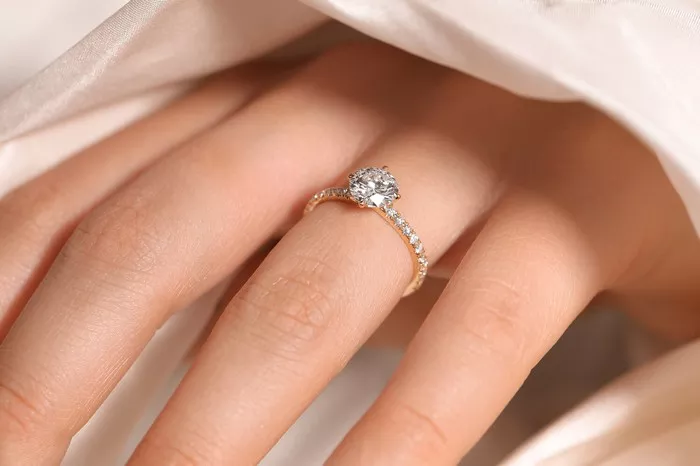Choosing an engagement ring involves many decisions, from the style of the setting to the type of gemstone. One of the most significant considerations is the carat size of the center stone, as it plays a crucial role in the ring’s overall appearance and symbolism. Understanding what constitutes an average carat size for engagement rings can provide valuable insights for couples navigating this important purchase. In this detailed article, we explore various factors influencing carat size preferences, trends in engagement ring choices, budget considerations, and practical tips for selecting the right carat size to suit individual preferences and lifestyles.
See Also: What Size Diamond Tennis Bracelet?
Factors Influencing Carat Size Preferences
The decision on carat size for an engagement ring is influenced by a combination of personal preferences, cultural norms, and practical considerations. Several key factors contribute to determining the optimal carat size:
Budget Constraints: Financial considerations often play a significant role in determining the carat size. Couples typically set a budget for the engagement ring, which guides decisions on the size and quality of the center stone.
Individual Style and Preference: Personal taste varies widely when it comes to jewelry. Some individuals prefer larger, more prominent stones, while others may favor a more subtle and understated look.
Cultural and Social Influences: Cultural norms and societal expectations can influence perceptions of the ideal carat size. In some cultures, larger stones may symbolize wealth and status, while in others, the emphasis may be on quality over size.
Lifestyle Considerations: The wearer’s lifestyle and daily activities can impact the practicality of different carat sizes. Those with active lifestyles may opt for smaller stones that are less likely to snag or get damaged, whereas others may prioritize aesthetic appeal.
Understanding Carat Weight and Size Perception
Carat weight refers to the measure of a diamond’s weight, with one carat equaling 200 milligrams. However, carat weight alone does not dictate the perceived size of the diamond. Several factors contribute to how large a diamond appears:
Cut and Proportions: The cut of the diamond significantly affects its brilliance and how light reflects within the stone. Well-cut diamonds can appear larger and more brilliant than diamonds with poor cuts, even if they have the same carat weight.
Shape of the Diamond: Different diamond shapes (such as round, princess, oval, emerald, etc.) can affect how large the stone appears. Some shapes, like ovals and marquise cuts, tend to appear larger per carat compared to round diamonds.
Setting Design: The design of the setting and any additional accent stones can influence the perceived size of the center stone. Halo settings, for example, can enhance the appearance of the center stone by adding sparkle and visual impact.
Trends in Engagement Ring Carat Sizes
Engagement ring trends evolve over time, reflecting changing preferences, cultural influences, and market dynamics. While individual choices vary, certain trends in carat sizes have been observed in recent years:
Shift Towards Larger Stones: There has been a noticeable trend towards larger center stones in engagement rings. Many couples are opting for statement pieces with stones above one carat, driven by desires for visual impact and personal expression.
Preference for Customization: Customization options have become increasingly popular, allowing couples to design rings that reflect their unique style preferences and budget constraints. This trend has contributed to greater diversity in carat sizes and settings.
Influence of Social Media: Platforms like Instagram and Pinterest have influenced engagement ring trends by showcasing various styles and sizes. Social media serves as a source of inspiration for couples seeking the latest designs and trends.
Budget Considerations and Affordability
Determining the budget for an engagement ring involves balancing financial considerations with preferences for carat size and quality. Several factors influence the overall cost of a ring:
Quality of the Diamond: The 4Cs—cut, color, clarity, and carat weight—determine the quality and value of a diamond. Higher-quality diamonds with better color and clarity grades command higher prices, regardless of carat size.
Alternative Gemstones: Some couples opt for alternative gemstones such as sapphires, rubies, or moissanite, which can offer larger carat sizes at a lower cost compared to diamonds.
Setting and Metal Choice: The choice of setting and metal (such as platinum, white gold, yellow gold, or rose gold) also impacts the overall cost of the ring. Intricate settings and precious metals can increase the price.
Practical Tips for Choosing the Right Carat Size
Selecting the ideal carat size involves considering personal preferences, budget constraints, and practical considerations. Here are some practical tips to guide the decision-making process:
Set a Realistic Budget: Determine a budget that aligns with financial goals and priorities. Consider factors such as savings, income, and other financial obligations when setting the budget for the engagement ring.
Prioritize Cut Quality: Invest in a well-cut diamond, as cut quality directly impacts the diamond’s brilliance and overall appearance. A well-cut diamond can appear larger and more dazzling than a poorly cut diamond of the same carat weight.
Try Different Carat Sizes: Visit jewelers and try on rings with different carat sizes to see how they look on your finger. Visualize the ring in various lighting conditions to gauge its sparkle and brilliance.
Consider Alternative Options: Explore alternative gemstones or diamond shapes that offer larger perceived sizes or better value for your budget. Moissanite, for example, is known for its brilliance and affordability compared to diamonds.
Conclusion
Choosing the right carat size for an engagement ring involves a thoughtful consideration of personal preferences, budget constraints, and practical factors. Whether opting for a classic solitaire or a modern halo setting, understanding the factors influencing carat size preferences can empower couples to make informed decisions. By prioritizing quality, considering customization options, and exploring alternative gemstones, couples can find an engagement ring that not only symbolizes their love and commitment but also reflects their unique style and preferences. Ultimately, the perfect engagement ring is a blend of meaningful symbolism, aesthetic appeal, and practical considerations that celebrate the beginning of a lifelong journey together.

